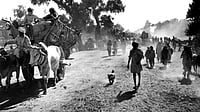Book: C
Authour: Anupama Raju
(Publisher, Aleph)
C which could also be sea or see, two cities, dark and light which form the cusp of Anupama Raju’s debut novel. Chennai and Canterbury, the mention of Tamil prompts the former, the latter a guess from her Charles Wallace fellowship, though Canterbury could also be Coventry which has a woman on a horse as well as a cathedral. Though speculations are not fair in a novel that wanders the spheres of seeing and unseeing and is haunted by the darkness that at first has the reader wondering whether it is pollution related or the darkness of cities in the far north. There is also the c of a campus where the writer wafts between the pages of verse and memories, thought that particular c does not feature except as a backdrop to the whole.
The darkness that Raju embraces is the darkness of depression, desolation, and despair filtered by the unsatisfying phone calls of a lover who is always the first to hang up, Raju’s is a dystopian world where she explores the soul of the writer who is love starved and hope deprived. The territory is not unfamiliar many poetic souls have trodden the same path, flitting in and out of book shops and libraries in lands far from home with angst and unrequited passion in their souls. In her case, she has an observer, the city of darkness who acts as a chorus watching the writer who has arrived in the dark domains with a gentle almost paternal eye, another daughter whom the city hopes will recover from the darkness of love through its therapeutic mentorship.
Obviously, the daughters of C are fated to meet though their first meeting too, is mysterious in the half-light half darkness that Raju rejoices in. However, the haze, in this case, is the dust among the shelves of a bookstore and the woman seems to have appeared from a medieval manuscript until her Tamil footnotes come to the writer’s hand. From that comes the lurch into the cruelties of school teachers back home in the other C.
The woman the writer encounters has a name, Alice, but she is someone no one else can see. A spirit who traversed the seas to the original C in the days before she became a spirit and met a prince by the sea shore. Both she and the writer believe in light and love but neither Alice says in her infinite wisdom, last throughout life. There is also a unique out-of-body encounter between the kindred spirits that may or may not help the writer, Raju’s alter ego it seems, to help her recover from her faltering love affair.
Alice we discover was burnt at the stake and darkened the skies over C. The meeting between the two was orchestrated by the dark C who feels that his writer daughter needs to be inspired by writing through a muse who has the quality of a shaman, C’s first original daughter. Early on in the book, the narrator walks between a pair of glowing eyes on a misty evening in an out-of-body experience that evokes the ghosts of old cathedral towns. However, that is not initially explained though followed up by an encounter with meds and a collapse. But the hallucinatory world links the reader to Raju’s residency where the writer is there in real time to write and the quest for inspiration may prove frustrating.
The poet-author takes the life of a schoolgirl in Tamil Nadu who grows up to be a rebellious writer in residence lost on campus and deconstructs it so that the familiar story of a bad schoolgirl with rolled socks who finds it hard to relate to her father acquires a haunting unfamiliarity. There is a collapse, meds, the mention of a shrink, and even a night in a luxury hotel which grounds the reader for a while but not for long. Poetry can turn the common inside out as it can take an all too ordinary unrequited love and turn it into drama, an unequal balance between two people that has to be written out of the soul. Poetry and line formations take sudden chunks out of pages making the reader pause as is obviously meant.
There is a uniqueness to the merging of the two Cs spanned by time and distance and underscored by Raju's nuanced language of blue-green hazes that underscores the misty wanderings of her narrative. There is a photograph of Eliot on the stairs to her lonely room and the circularity of his poetry imbues her story with an 'in my end is my beginning' feel as the relationships toss and turn or drop like leaves with the changing seasons. Life, Raju muses, is about drops in one sense or the other and her chapter titles contribute their own lines of verse to the tale.


























